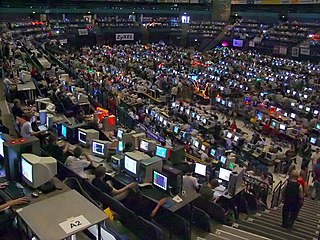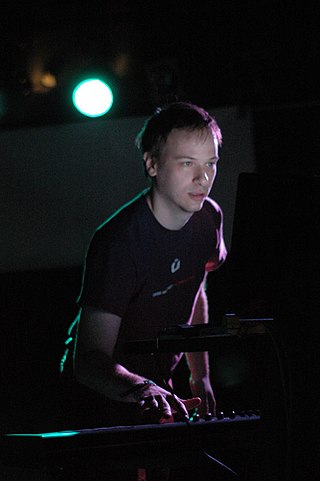
Future Crew was a Finnish demogroup that created PC demos and software, active mostly between 1987 and 1994.

Future Crew was a Finnish demogroup that created PC demos and software, active mostly between 1987 and 1994.
The group was founded in 1986 by PSI (Sami Tammilehto) and JPM (Jussi Markula) as a Commodore 64 group, before moving to the PC demoscene in 1988; other members included, over time, Trug, Wildfire, Pixel, ICE, GORE, Abyss, Purple Motion, and Skaven, as well as several others.
Noteworthy demos by Future Crew include Unreal (released at Assembly 1992), Panic (released at The Party 1992) and Second Reality (released at Assembly 1993). Second Reality may be considered one of the most influential PC demos ever made. [1] Future Crew was also responsible for the popular MOD editor Scream Tracker , which was fashioned after the Amiga Soundtracker as well as the Advanced DigiPlayer sound editor, and later became itself inspiration for other trackers like Impulse Tracker. [2] [3] [4]
Future Crew was co-organizer of the first Assembly demo party in 1992, and continued organizing the annual party until 1995, when the organization set up the Finnish company ASSEMBLY Organizing in order to "provide a solid financial basis for the events and a reliable partner for our sponsors". [5] Long time Future Crew member Abyss is one of the party's main organizers.
Future Crew did not release anything as a group after Scream Tracker 3 (July 1994). While it was never officially dissolved, its members parted ways in the second half of the 1990s. Companies like Futuremark (3DMark), Remedy ( Death Rally , Max Payne , Alan Wake ), Bugbear Entertainment ( FlatOut , Glimmerati, Rally Trophy), Bitboys (a graphics hardware company) and Recoil Games ( Rochard ) were all started in whole or in part by members of Future Crew. Prior to their dissolution they also contributed graphics to the game Ken's Labyrinth published by Epic MegaGames. [6] Skaven contributed music to Unreal Tournament 1999.
Future Crew was an influential pioneer of the PC demoscene and the PC as multimedia device in general, and achieved wide public recognition. [7]
Slashdot voted the Future Crew Demo Second Reality as one of the "Top 10 Hacks of All Time". [7] Tributes to Future Crew include a 3D graphics benchmark called Final Reality by Remedy Entertainment (shown at Assembly 1997), and a remake of Second Reality for the Commodore 64 by Smash Designs called Second Reality 64 (released at The Party 1997). Nectarine Records has released a free-to-download album titled "Metropolis" containing the most known songs of Future Crew in 24-bit remastered as a tribute. [8]

These are the members of the group at the time it released Second Reality:
Future Crew released the following productions on the PC demoscene :

Amiga demos are demos created for the Amiga home computer.

Demogroups are teams of demosceners, who make computer based audio-visual works of art known as demos. Demogroups form a subculture collectively known as the demoscene.

The demoscene is an international computer art subculture focused on producing demos: self-contained, sometimes extremely small, computer programs that produce audiovisual presentations. The purpose of a demo is to show off programming, visual art, and musical skills. Demos and other demoscene productions are shared at festivals known as demoparties, voted on by those who attend and released online.
Scream Tracker is a tracker. It was created by Psi, one of the founders of the Finnish demogroup Future Crew. It was written in C and assembly language.
The computer art scene, or simply artscene, is the community interested and active in the creation of computer-based artwork.

The Assembly demoparty is a demoscene and gaming event in Finland. It is the biggest demoscene party. The main organizers of the event are Pekka Aakko and Jussi Laakkonen. The Summer event takes place every year between late July and early August, and lasts three to four days, and the Winter event is held in January or February. Edition 2020 was online. The most recent Assembly was held from 1 to 3 April 2022 at Messukeskus in Helsinki.
Melon Dezign was an Amiga demoscene group founded in Denmark on October 21, 1991 by Seen and Paleface. Originally, they were a subgroup of Crystal, where they at first exclusively created intros for cracked games. Shortly after the formation, they were joined by Bannasoft, and after helping organise The Party, a demo event with more than 1200 attendees, several other members joined, including Walt, Mack, Performer, Audiomonster in France, Mikael and Benjamin in Norway and Mark Knight otherwise known as TDK in the UK.

Andrew Gregory Sega, also known as Necros, is an American musician best known for tracking modules in the 1990s demoscene as well as for composing music for several well-known video games. He was a member of the synthpop duo Iris from 2001 until its disbandment in 2021. In 2020, he founded the dark wave duo Hallowed Hearts.

Breakpoint was a German demoscene party. From 2003 to 2010, it took place annually at Easter in Bingen.

The Kosmic Free Music Foundation was a worldwide group of computer musicians, artists, and coders focused on the PC demoscene. Most members were from the United States, Canada, and Australia. They created music—mostly techno, trance, and ambient—with tracker software. They also created some artwork and demos. All their productions were available to download without charge from BBSes and the internet. In the 1990s, they were known for having many of the tracking scene's top musicians as members. Their early presence on the Internet made them one of the first netlabels. The leader of Kosmic was Dan Nicholson, who went by the alias Maelcum.
Peter Hajba, also known by his demoscene nickname Skaven, is a Finnish electronic musician, video game composer and graphic artist. His most recent project is with Remedy Entertainment as an animator, sound designer and graphic artist. Prior to working with Remedy, Hajba has been credited on games developed by 3D Realms, PopCap Games, Introversion Software Limited, Epic Games, and Housemarque.

Jonne Valtonen is a Finnish composer, arranger and orchestrator. He is renowned for his contributions in the field of demoscene and tracker music, under the name Purple Motion, and with Future Crew.

Second Reality is an IBM PC compatible demo created by Future Crew. It debuted at the Assembly 1993 demoparty on July 30, 1993, where it was entered into the PC demo competition, and finished in first place with its demonstration of 2D and 3D computer graphics rendering. The demo was released to the public in October 1993. It is considered to be one of the best demos created during the early 1990s on the PC; in 1999 Slashdot voted it one of the "Top 10 Hacks of All Time". Its source code was released in a GitHub repository as public domain software using the Unlicense on the 20th anniversary of the release on 1 August 2013.

Pilgrimage was a demoparty which took place annually in Salt Lake City, Utah each summer between 2003 and 2006. The event was founded by Rich "Legalize" Thompson of the demoscene group Polygony. Pilgrimage was, at the time, the only active demoscene event of its kind in all of North America, while many demoparties take place annually throughout Europe.
Tristar and Red Sector Incorporated (TRSI) is a demogroup which formed in 1990. It came about from the longest-running cooperation in scene history. RSI existed from 1985, before being joined by the "T" later on. Evolving from the Commodore 64 to the Amiga and later to PC and various game console platforms - like the PlayStation, Xbox, Nintendo - and set-ups like Arduino, Android or Blu-ray, TRSI released a number of digital productions, dedicated to experimenting in phreaking or network alteration. Its members were spread around the world and still contribute to computer scene art and code after more than 27 years of history.
keWlers is a Finnish demogroup, formed in the early 1990s, originally called Mewlers. After smaller releases such as Tripfish 2 or Another High-Caliber Mechanical Complication, their breakthrough came in 2002 when they released their critically acclaimed demo Variform at Assembly 2002. Despite only achieving third place, the demo became one of the most widely known and top rated demos ever released, winning three Scene.org awards. Further major demos to be released later included Protozoa and A Significant Deformation Near The Cranium, released at Assembly 2003. Kewlers have been nominated for at least one Scene.org Award every year, except for 2004. The group disbanded for a while in 2006 directly after the release of their final demo, 1995. But since 2010 Kewlers have returned from their hiatus, with possibly Variform 2, released at Revision 2012, as their most influential demo since their comeback.
Triton (TRN) was a demogroup active in the PC demoscene from 1992 to about 1996.
Andromeda Software Development is a Greek demogroup that was formed in 1992. They produced a number of small intros and demos in the mid-1990s for the PC, most notably CounterFactual and Beyond. ASD was quiet for the following years until 2001, when they presented Cadence & Cascade - their first accelerated demo - and won the Digital Nexus demoparty, held in Athens, Greece.
Misko Iho is a Finnish film director.

Kindergarden (KG) is an annual demo party first organized in 1994 in Fjellfoten, Norway. During the first few years it was held irregularly, eventually settling into being an annual event. Since 2001 it has been held in Haga, Norway, the location also used for Kindergarden 4 and 5.
Second Reality by Future Crew - Awesome, Mindblowing, Unbelievable, Impossible. Some of the words used to describe what this piece of code from demoscene gods Future Crew did on 1993-era PC hardware. Even by today's standards, what this program can do without relying on any kind of 3D graphics acceleration is impressive. As if the graphics weren't impressive enough, it can even playback in Dolby Surround Sound.
When PCs first came of age for music making in the mid '90s, ScreamTracker was one of the first music software packages to appear with sample support,...